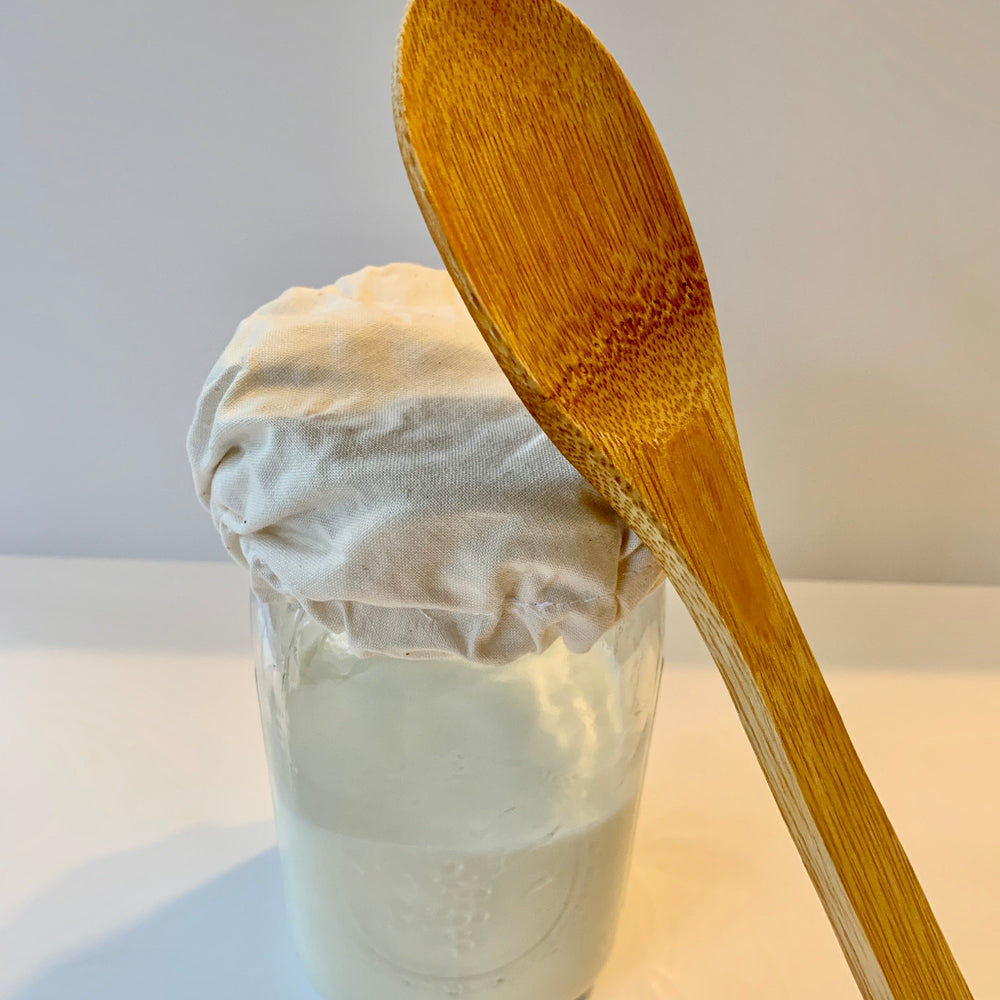
To stir or not to stir, that is the question.
Does stirring or shaking or agitating the jar improve milk kefir?
There are 3 lines of thinking in the milk kefir community when it comes to stirring or agitating the jar:
- The first idea is that you should not disturb the ferment. Just add the milk and let it sit for 24 hours.
- The second line of thinking is that 1-2 stirs or shakes in the middle of the ferment will help benefit it the most.
- The third line of thinking is to stir or agitate it as much as possible. Every 2-3 hours is ideal.
I've gone back and forth over the years, but these days I believe #2 to be the most ideal.
When you ferment milk kefir correctly, it doesn't necessarily need to be stirred or shaken up to make a good kefir. However, it can taste more balanced and less yeasty with 1-2 stirs mid way through.
Was kefir traditionally stirred?
Traditionally, milk kefir was fermented in goat skin bags and agitation was common and expected. At least once or twice. The unusual and varying shapes of the bag would mean that the grains and milk would likely not be distributed evenly. The agitation or shaking of the bag would be needed to redistribute to grains and milk for a more even ferment.
In the Caucasus mountains, people would hang the goats skin bag near the entrance so that anyone coming or going could lightly shake the bag.
In modern times, we tend to ferment in glass jars that keeps the milk relatively centered within the milk. That means that even if you don’t stir or shake, it comes out (mostly) evenly fermented. So stirring / shaking is not quite as needed as it was on the past.
Now if you have a tall skinny jar with a lot of grains, then the milk at the top ferments fast and the bottom slower. So agitation or stirring would be required for a more even ferment. The overall consistency would also be thicker.
Taste
I think this is where stirring has the most benefit. It can make quite a difference in flavor to just stir it once or twice.
Yeast tends to be faster and more opportunistic, so the yeast tends to thrive further away from the grains. When you stir, you redistribute the milk and the bacteria stays strong and keeps the yeast in check better.
Basically that means a more balanced flavor between the bacteria and yeast. With stirring, it will tend to be more sour and less fizzy or yeasty.
When I stir excessively (every couple hours), what I find is a very strong sour flavor with less fizz.
When I stir once or twice, I get a nice balance between the two and it becomes the most pleasant. For me that's the sweet spot.
Summary:
- No stirring creates both a strong sour and strong fizzy flavor
- 1-2 stirs per ferment creates a nice balance between the bacteria and yeast
- Multiple stirs creates a strong sour flavor with less fizz
Whey
When you ferment milk kefir properly, stirring will lower the amount of whey, especially at the bottom of the jar. The more stirring, the less whey.
Stirring Experiment
We did an experiment with 3 jars. The first jar we didn't stir. The 2nd jar, we stired only once midway through. And the 3rd jar we continually stirred every 2-3 hours.

No Stir (notice the amount of whey at the bottom)

1 Stir midway (slightly less whey at the bottom)

Multiple stirs throughout the ferment (very little whey at the bottom, but more whey near the grains at the top)
When you have good ratio of milk to grains, then stirring will usually help limit the amount of whey. The more stirring or agitation you give them, the less whey you will generally have.
However, if you have too many grains for the amount of milk, it will over-ferment and you will practically have nothing but whey at the end.
Thickness
The general consensus is that stirring will improve the thickness and consistency.
When we test wide-jar small batch ferments at ideal temperatures (low 70's), we don't really see an improvement of thickness with any amount of stirring. This is likely because conditions are already ideal and the grains have excellent access to the milk regardless of stirring.
However, if you have a skinny jar or do large batches where the grains sit at the top and there is a large amount of milk below them, then that's where stirring will help improve the consistency.
What happens in that case is that the top gets really thick and the bottom stays thin and when you mix together, it will come out thin and inconsistent. Stirring really helps in this case. It will help keep the milk consistent and thicker.
Bottom line
Stirring is not needed under ideal fermenting conditions such as small batches with wide jars fermented in the low 70's. However, even then 1-2 stirs can improve the flavor and keep the yeast down a bit. Excessive stirring can make it too sour and less pleasant.
If you are doing large batches or using skinny jars, stirring is a MUST. It will prevent inconsistent, poor tasting batches. Multiple stirs or shakes will improve even it even more. However, it is still recommended that you do smaller wide jar batches whenever possible.
Also if its too cold, stirring will help as well.
If you are using too many grains for the amount of milk and you try to stir, the end result will be practically nothing but whey. If you stir and you are getting too much whey, try a ratio such as 1 teaspoon per cup.
My personal preference is to do small batches of about 2-3 cups with 2-3 teaspoons of grains in a wide jar. When I ferment like that, stirring is not needed, but 1-2 stirs mid way through does improve the overall flavor a bit. If I'm out or forget about stirring, its still ends up good.
Do you stir your kefir?


Comments
Zach
I stir once or twice too. I’ve also found that a good vigorous shake just before straining makes the kefir pour through very easily & without having to use a spoon. So convenient!
Thanks for the site, very informative
July 12, 2021
RK Remmen
I like to do 1T grains per cup and stir 2 or three times in 24h to get a nice thick, moderately tart brew with a small amount of whey.
March 12, 2020
Leave a comment